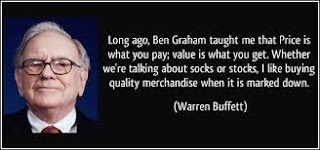I consider several factors when selecting an investment for
the Dividend Farm. It’s not just a function of building a Top 10 list and grabbing
something from it. Dividend
Yield affects my portfolio’s cash stream so it’s one of many variables I review.
Sector
or industry is important for diversification
and risk
mitigation. Dividend
Growth Rate is a factor I consider, but it doesn’t carry as much weight as
others.
One variable I pay attention to is the Price-to-Book (P/B)
ratio. If price is what you pay and value is what you get, how is value
determined?
Finding the book value of a company is one way to go about it. Book value is a firm’s total assets less its intangible
assets and liabilities per Investopedia.
Dividing this figure by the number of shares outstanding results in book value
per share. Comparing book value per share to the current price per share of the
stock results in the Price-to-Book ratio indicating to me how much value I may
receive for the money paid out.
Am I paying more or less per share for a company than I
might receive if it were liquidated and the net proceeds distributed? I’ll hesitate to buy a stock if the P/B is in
excess of 2:1 in most cases. I don’t like to pay more than $2 for every $1 I
receive in value unless there are other favorable factors that can mitigate the
risk associated with a high P/B ratio.
Below are the Top 10 Dividend Champions based on the
Price-to-Book ratio as of December 2, 2019.
If you’re interested in any of these firms you can find updated P/B
figures through your broker or in many cases via Yahoo! Finance.
|
Dividend
Champion
|
P/B
|
|
Telephone & Data Sys.
|
0.59
|
|
People's United Financial
|
0.94
|
|
Universal Corp.
|
1.01
|
|
First Financial Corp.
|
1.04
|
|
Helmerich & Payne Inc.
|
1.07
|
|
United Bankshares Inc.
|
1.15
|
|
NACCO Industries
|
1.16
|
|
Old Republic International
|
1.17
|
|
Weyco Group Inc.
|
1.17
|
|
Chubb Limited
|
1.26
|
Do not select a stock based on the P/B value of a firm alone
any more than picking a stock based solely on one of the other Top 10 lists. As discussed above, many factors should be
included in your analysis to mitigate risk and ensure you’re investing rather
than speculating. This is why it’s
important to keep
learning. If you do that while compounding
your dividends you can expect your investing savvy, portfolio size, and dividend
cash flow to flourish.
Thoughts presented are those
of the author, who is not a financial professional. Perspectives are not
investment advice, but offered for the purpose of discussion and information.
For specific investment advice or assistance, please contact a registered
investment advisor, licensed broker, or other financial professional.

No comments:
Post a Comment